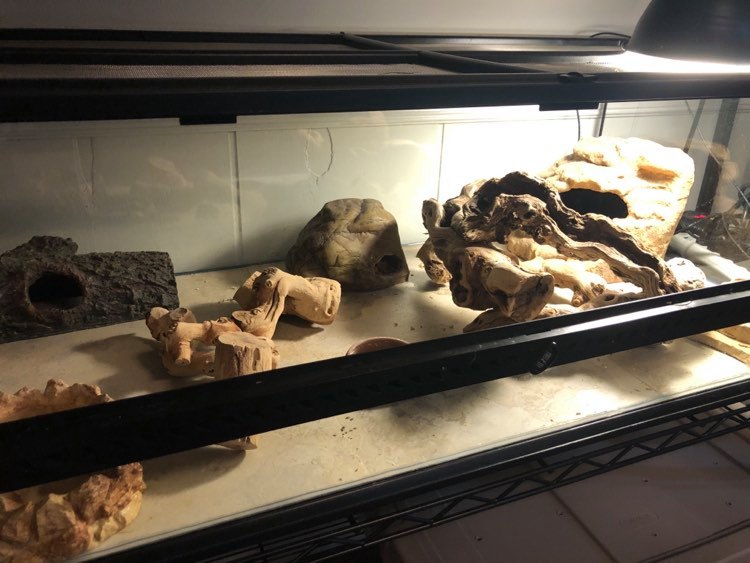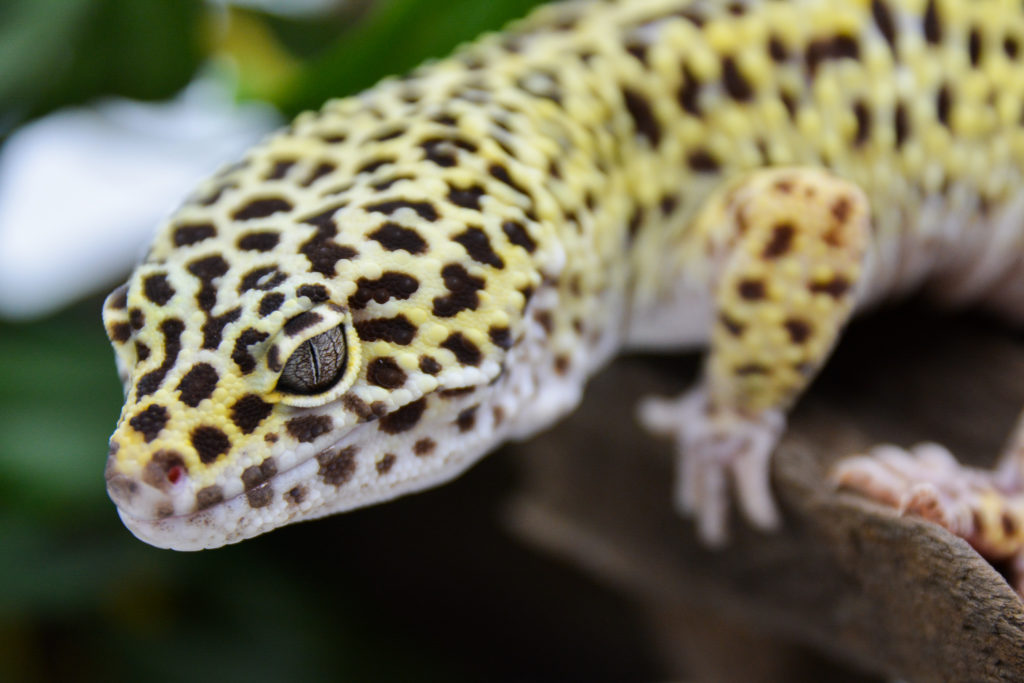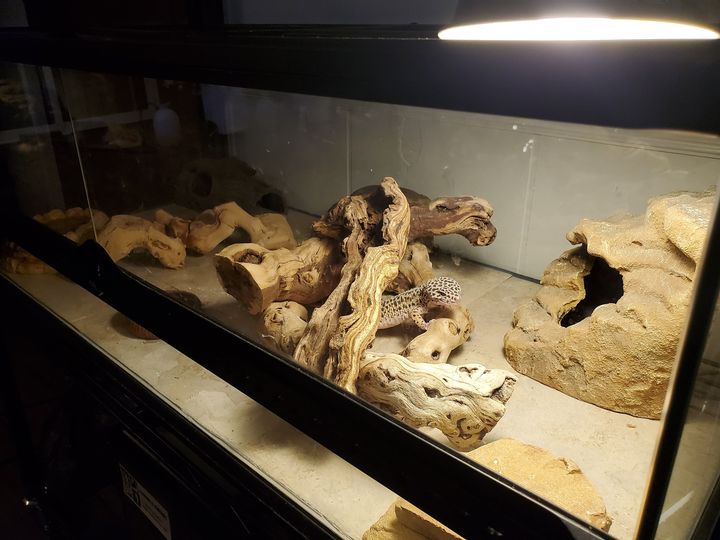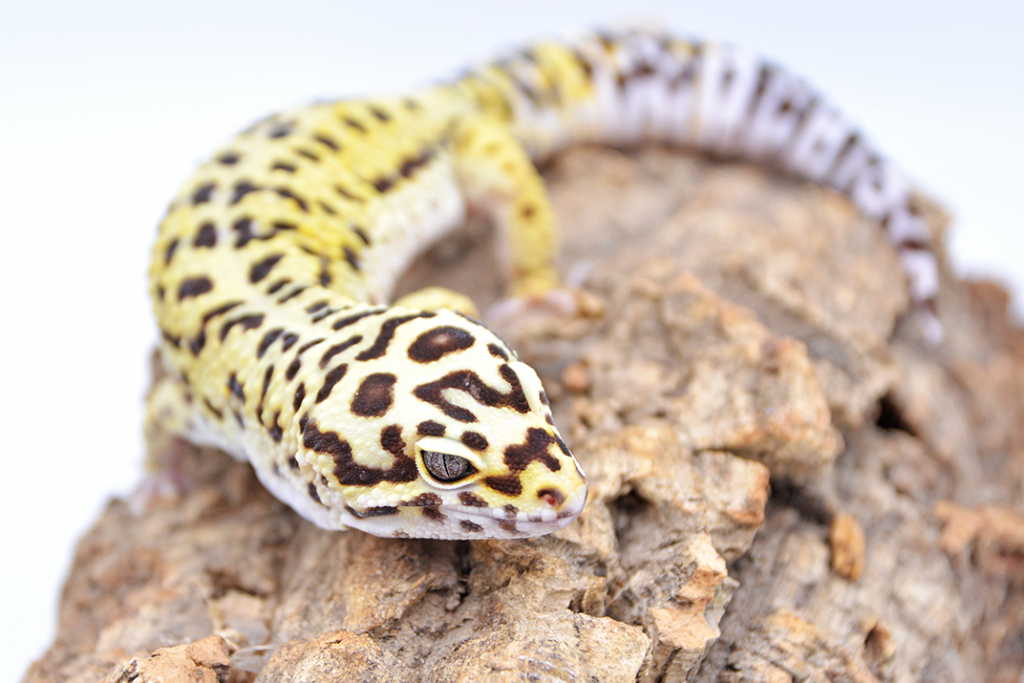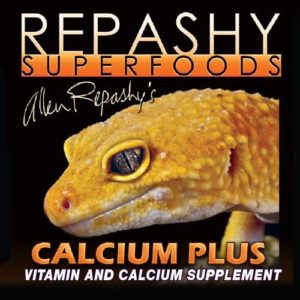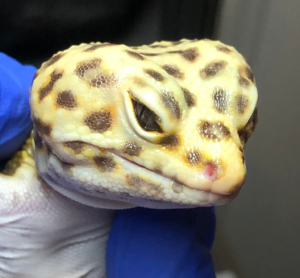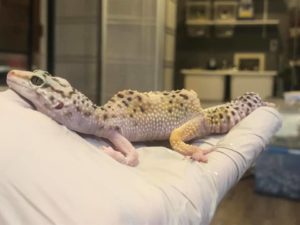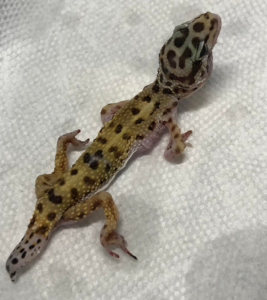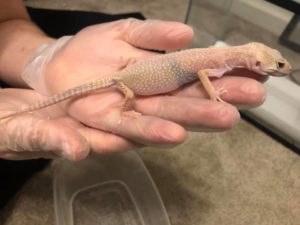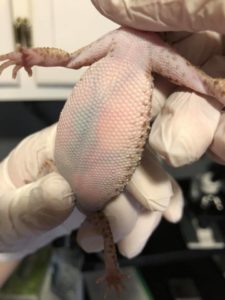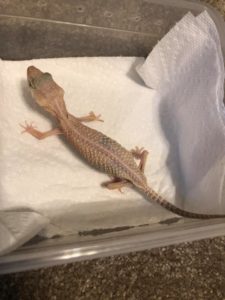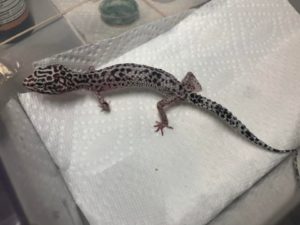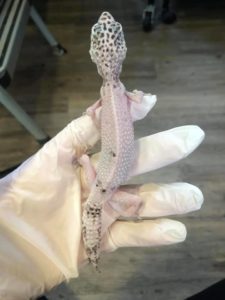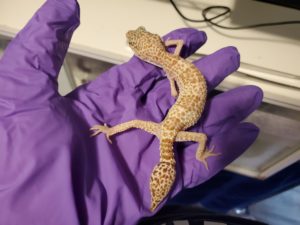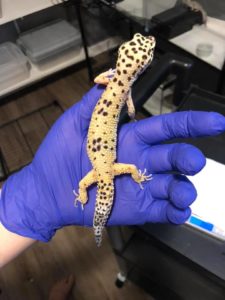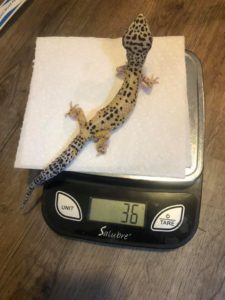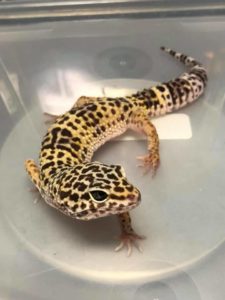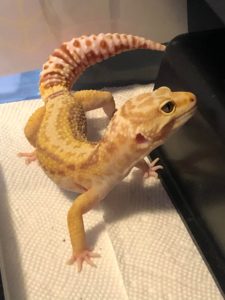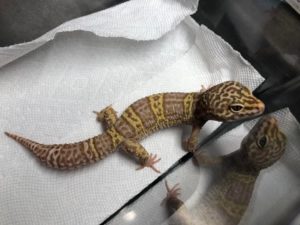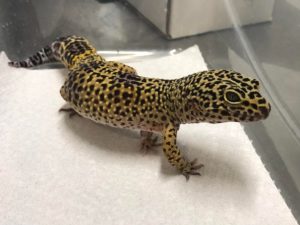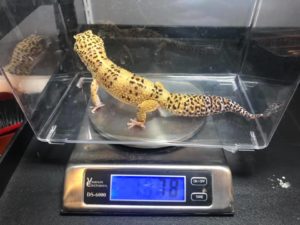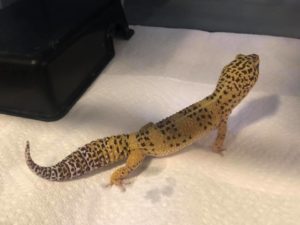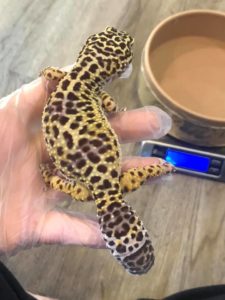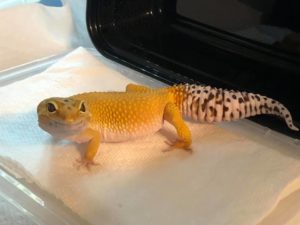Source: https://bewildnc.org/leopard-gecko/

LEOPARD GECKO
Species name: Eublepharis macularius
Lifespan: 10-20 years
Origin: Afghanistan, Iraq, Iran, and northwest India
Adult size: 7-12 inches
Caging
Some sources recommend cages as small as a 10 gallon, we personally believe that a 20 gallon cage should be the absolute minimum for an adult. A 40 gallon tank is even better! Plastic tubs of similar sizes can also be modified into suitable enclosures. Leopard geckos are terrestrial, so the cage should be longer than it is tall to provide the maximum amount of floor space.
Decor
Leopard geckos should be provided with 3 hides – a hot hide, a cool hide, and a moist hide. The moist hide should be filled with damp paper towels or sphagnum moss and should be placed in the middle of the tank (half on/half off the UTH pad). Fake plants and structures should be added to allow your leopard gecko to climb and explore.
Substrate
Our personal favorite is tile! It is safe, attractive, and easy to clean. Other suitable options include paper towels, reptile carpet, or a sand/soil mixture. While reptile carpet is acceptable, it can be hard to keep sanitary. We advise against keeping them on only sand, as it has been known to cause impaction. Sand/soil mixtures should only be used in bioactive enclosures and only with advanced reptile keepers. For new keepers, we recommend against using particulate substrate.
Humidity
The ambient humidity in the cage should be low, at 30-40%. Humidity must be provided via a humid hide, which is a small hide kept humid for the gecko uses when shedding. Any enclosed hide can be used and then filled with damp paper dowels or damp sphagnum moss.
A 36" leopard gecko enclosure.
Tile is a great substrate option - simple and easy to clean!
Heating
Several different heat sources can be used for leopard geckos. Whatever heat source you choose to use, the hot side of the tank should be 88-90 degrees Fahrenheit and the cool side of the tank should be in the low to mid 70s. We’ve listed a few of the commonly used options below:
-
Heat Pads: We personally favor using under tank heat pads controlled by reptile thermostats. These are safe to use and keep the hot spot at a consistent temperature. They also do not dry out the air and don’t give off any bright light, which may cause stress in some leopard geckos if they’re not provided with enough coverage. We’ve personally had great success using regulated heat pads while rehabbing leopard geckos with various medical conditions.
-
Radiant Heat Panels/CHEs: Overhead heating elements, such as radiant heat panels and ceramic heat emitters may also be used. These produce heat, but do not emit light. Radiant heat panels do a good job of dispersing heat inside larger PVC cages. Both of these options can be used at night without interrupting the animal’s day/night cycle.
-
Incandescent/Halogen Lighting: Some leopard gecko keepers strongly recommend providing heat with a halogen light as they have been shown to most closely replicate the sun by providing IR-A, IR-B, and IR-C. The most commonly recommended lights are PAR30, PAR36, or PAR38 outdoor halogen flood lamps. We personally have not seen conclusive evidence that these lamps are more beneficial to reptiles or improve their overall health – but we are keeping up-to-date on current research and are excited to see the results of some ongoing studies. We do believe this to be a viable husbandry option, however, and many keepers are able to keep leopard geckos successfully using these lamps. Strong overhead lighting can dry out the enclosure and may be stressful for some geckos. However, these issues can be rectified. Being an arid species, you can typically avoid any humidity issues by consistently keeping the humid hide moist and clean. By providing lots of decor and foliage, you can give the gecko lots of hiding places to avoid the light if it desires. Also be careful to ensure that the gecko cannot touch the bulb itself, as they are capable of causing burns.
-
Reptile-Branded Basking Bulbs: Reptile-branded basking bulbs can also be used, but we find that they have the same downsides as halogen flood lamps without many of the reported benefits. They’re also typically overpriced!
-
Night-Time Heating: If a heat pad, radiant heat panel, or ceramic heat emitter are being used, these can be used at night without distrubing the animal’s sleep cycle and no additional night-time heat is needed. If overhead lights are being used as the primary heating source, they should be turned off at night. A temperature drop at night time is OK and is actually believed to be beneficial. In their natural habitat, the temperature often drops down to 60F. However, if the temperature in your house is regularly dropping below 67F, I would considering providing a heating element at night. Deep Heat Projectors are a popular choice for supplying night-time heat, as they produce IR-A and IR-B, and are also reported to provide “deep muscle heating.” This technology is fairly new to the reptile world and we have not seen evidence that it definitively improves overall health or quality of life, but the topic is still being researched. Alternatively, you can also set-up a ceramic heat emitter to turn on only at night.
Lighting
Because leopard geckos are nocturnal animals, the necessity of UVB for them is a highly debated topic. Personally, we do provide a 5% UVB bulb for our ambassador leopard gecko, but have kept them successfully with and without UVB and don’t feel that it’s strictly necessary. However, if you have an albino leopard gecko, be aware that strong lights can irritate their eyes. Regardless of what lighting you choose to provide, make sure to provide a day/night cycle by keeping the lights on during the day and turning off all lights at night. If you are not using an overhead heating bulb or UVB light, you can provide this day/night cycle using the room’s ambient lighting or an LED light.
If you do decide to provide UVB, the
Arcadia Shade Dweller is a popular choice!
Diet
Leopard geckos should be fed a diet consisting entirely of live insects. Crickets, dubia roaches, mealworms, and superworms are the insects most commonly used as a staple diet for leopard geckos. There are many other insects you can include at smaller amounts in their diet, including wax worms, silk worms, and hornworms. We keep a variety of different feeders on hand and rotate through them, variety is the key to a healthy diet. Insects should be “gut-loaded” prior to feeding, meaning they should be fed a nutritious diet prior to feeding them to your gecko. They can be gut loaded with a nutritious powdered diet or fresh vegetables.
Juvenile and adult leopard geckos eat at different frequencies and amounts. Juvenile geckos who are still growing should eat 4-7 days a week, with newborns eating daily. For a growing gecko, feed 2 appropriately sized insects per inch of leopard gecko each feeding. For adult geckos, we feed feed 3-4 times a week and offer 3-5 insects per feeding. This can be increased or decreased based on their body condition; some adults can be prone to obesity, so keep an eye on their weight. An appropriately sized insect is one that is approximately the same length as the space between your leopard gecko’s eyes. Make sure to adjust your leopard gecko’s diet based on their weight. We have provided a chart below to help you assess your leopard gecko’s body condition.
Leopard geckos can easily become overweight - make sure not to overfeed!
Supplementation
In captivity, leopard geckos require supplemental calcium and multivitamins which can be provided by dusting their insects. We recommend dusting twice a week with calcium with D3 and once a week with a multivitamin powder. Alternatively, you can use a product like Repashy Calcium Plus, which includes both calcium and multivitamins. We also recommend keeping a small bowl of calcium without D3 in the enclosure. If you are using a UVB light (and your gecko spends time under it), your leopard gecko should be producing its own D3. In this case, you may want to dust the majority of their insects with calcium without D3 instead.
Water
A small bowl of clean water should always be available and cleaned regularly.
Repashy Calcium Plus is one of our favorite products!
Things You Should NOT Do
Use a red heat lamp: Leopard geckos CAN see red light and this will disturb their sleeping cycles. If you need additional heat at night, use a ceramic heat emitter.
Use a heat rock: While many pet stores will try to sell you a heat rock, they are extremely dangerous. Do not use them for any animal. Heat rocks are not well regulated and can reach temperatures high enough to severely burn your animal.
Cohabitate: Leopard geckos are not social animals and should never be housed with another leopard gecko. They can, and often will, show aggression towards eachother. While some keepers have kept females together successfully, our favorite saying is “It’s never a problem until it is.”
Fennel is a bearded dragon that was surrendered to BeWild with severe burns caused by a heat rock.
Common Health Issues
Hypovitaminosis A: When leopard geckos don’t get enough vitamin A, they can develop a condition that causes the eyes to form a hard cellular debris. In advanced cases, this can spread to the mouth. It will cause blindness and pain, and animals with hypovitaminosis A should be brought to the veterinarian for potential debridement, supplements, and nutritional support if it has not been eating. Do not try to dose human vitamin A supplements; if given too much vitamin A, reptiles can develop skin sloughing issues and it can be just as serious.
Hypovitaminosis E: In recent years, Vitamin E deficiencies are being observed more frequently in leopard geckos. It seems to be more often seen in “higher end” leopard gecko morphs, so there is some thought that inbreeding may be causing these geckos to be genetically predisposed to it. Vitamin E deficiencies cause fat tissues to become necrotic, leading to inflammation in the muscle. The primary symptom we see is bilateral enlarged masseter muscles, though we have also seen masses throughout the body. We have gotten in three leopard geckos with this condition, one of which we took in for a biopsy of these swellings. The biopsy showed 100% muscle tissue. Treatment includes supplemental vitamin E, selenium, and possibly an anti-inflammatory. The prognosis for advanced cases is grave.
Parasites: Leopard geckos can carry many different types of parasites, including pinworms, coccidia, spirochetes, and protozoans. It is common for leopard geckos to have a small level of parasites, this is normal for their gut flora. However, when a leopard gecko is sick or stressed, the parasites can take over and cause diarrhea, weight loss, and anorexia. This can become serious, so bring a fecal to your veterinarian if your gecko is exhibiting the above signs.
Metabolic Bone Disease: Captive lizards need supplemental sources of calcium, or else they will develop MBD. We see this frequently in surrendered animals, and in severe cases the animals can die. When a gecko doesn’t have enough calcium, its body will start to pull calcium from its bones to support heart and organ function. Eventually, they get so weak they cannot walk properly, stand, or eat. The first signs of MBD include curved legs and weak jawbones, and this can advance as the gecker loses more calcium from the bones. Always see a veterinarian to get an exam on your animal’s condition; most of the time, your vet will give you a prescription liquid calcium to give orally. You should also correct your diet to include calcium-dusted insects, gut load your insects with a calcium-rich food. Geckos with MBD should be provided UVB lights to help strengthen
their bones.
Mouth Rot: Mouth rot is a condition where the mouth develops a bacterial infection. This can be due to a dirty water source or dirty enclosure, a wound in the mouth that becomes infected, or stuck shed around the face. Mouth rot can quickly become serious, as it is painful and will cause the gecko to not want to eat. You should see a veterinarian to clean out the mouth and start an antibiotic regimen. Make sure to always maintain a clean environment.
Dysecdysis/Retained Shed: Pet leopard geckos often have issues with stuck shed, as they need a humidity hide in order to shed properly. A gecko should always finish shedding in 24 hours. If they have retained shed, soak the gecko in a shallow bin of warm water and gently remove the shed with a cotton swab. If retained shed is left on the gecko’s toes, it can constrict around the toes and cause them to become infected and necrotic. Retained shed can also occur in the gecko’s eyes, which can cause blindness, anorexia, and infection. If your gecko is having chronic issues with retained shed, or if there is infection and necrosis, see a veterinarian and immediately correct your humidity issues by providing a humid hide.
Cryptosporidium: Cryptosporidium is a type of parasite that can cause deadly infections in leopard geckos. It causes a condition called “stick tail,” named because geckos with chronic crypto infections become emaciated and their tail becomes stick thin. This is a serious condition that has no treatment and is highly infectious. Always quarantine any new geckos, and be especially careful with geckos from pet stores. Crypto is best diagnosed by sending a fecal sample to a testing lab via your veterinarian. While a vet can identify crypto eggs in the fecal, there are many different species of this parasite and not all cause disease, so a sample should always be sent for genetic testing to be sure. Crypto eggs are notoriously hard to kill; if your gecko dies from crypto, you should throw away all of the equipment it touched. Bleach and traditional disinfectants do not disinfect against crypto.
Hepatic lipidosis: This is the term for “fatty liver disease,” and is a common malady in overweight reptiles. This is common in geckos fed high-fat diets, such as waxworms, superworms, and mealworms. Superworms and mealworms can definitely be used as a part of a balanced diet, but waxworms are especially high in fat and should only be fed sparingly. If a gecko gets too much fat in the diet, the body cannot process it all and fat starts to deposit in the liver. In advanced cases, this causes anorexia, fluid buildup in the body, regurgitation, and death. See a veterinarian if you are concerned your gecko has hepatic lipidosis. They will likely recommend a diet change and feeding consistent amounts of low-fat foods.
Prolapse: Cloacal can happen in both male and female geckos, but male geckos are more prone to get hemipenal prolapses. A prolapse is an emergency that should see a veterinarian immediately. If it is recent, sometimes the vet can push the prolapsed tissue back in and place a temporary suture, but advanced prolapses can become infected and necrotic. Some will need amputated.
Follicular stasis: Follicular stasis is a reproductive disease that occurs in female leopard geckos. It may be more common in geckos that are overweight, as it is common for female reptiles to put extra fat and protein toward egg development. Follicular stasis presents as a bloated, swollen abdomen and anorexia. The gecko may start to lose weight in the other areas of the body, such as the tail. This is also a veterinary emergency, and your gecko will need surgery to remove the follicles. Follicles are the beginning of reptile eggs, and are not yet calcified. If the follicles are not removed, they can become infected or burst inside the body, causing a condition called yolk coelomitis. This condition can become deadly, so seek veterinary assistance immediately.
A gecko with eye issues due to hypovitaminosis A. This gecko fully recovered!
A gecko with an advanced Vitamin E deficiency. Providing a multivitamin is very important!
Another example of hypovitaminosis E.
This leopard gecko was surrendered with severe Metabolic Bone Disease.
Another advanced case of MBD.
This gecko came in with extremely advanced cryptosporidium.
The large white masses (follicles) with a reddish tinge can be a sign of folliuclar stasis. This gecko had the follicles removed and recovered!
Body Condition Score Chart
1 – Emaciated
1 – Emaciated
1 – Emaciated
2 – Underweight
2 – Underweight
2 – Underweight
3 – Healthy
3 – Healthy
3 – Healthy
4 – Overweight
4 – Overweight
4 – Overweight
5 – Obese
5 – Obese
5 – Obese
GET IN TOUCH
- Durham, NC
- 919-442-8238
- info@bewildnc.org
We work exclusively with pet reptiles, amphibians, and invertebrates. If you find injured wildlife, please contact a licensed wildlife rehabilitator.
We are unable to take in yellow-bellied sliders and iguanas due to space restrictions. We are unable to take in red-eared sliders, as they are illegal to own in NC without a Restricted Species permit.
FOLLOW US
Facebook-f Instagram
